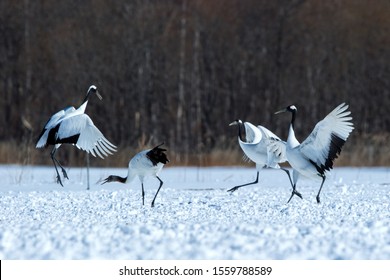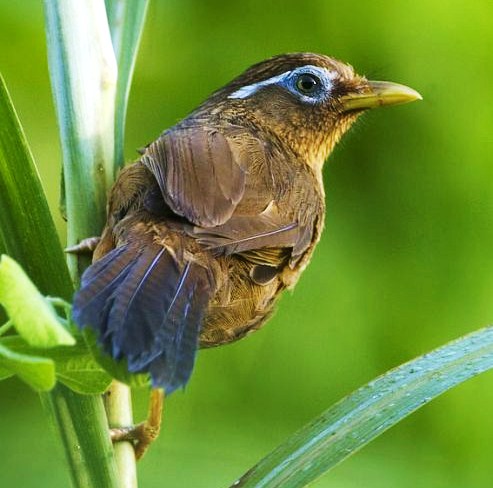
Celebrating Cranes and Wildlife Conservation Education
Red-crowned Crane (Grus japonensis) Fact Sheet: Physical Characteristics

As a nature enthusiast and bird photographer, I have always been fascinated by the unique characteristics and behaviors of various bird species. Among these, cranes stand out as some of the most intriguing and awe-inspiring birds that I have had the pleasure of observing. And what makes them particularly fascinating is their stark differences from other related species like storks, herons, and egrets.
For one, cranes have distinctively long necks, legs, and bills, which sets them apart from their close cousins. They also have a more upright posture, which makes them stand out in any landscape they inhabit. In contrast, storks, herons, and egrets have curved necks and bills and tend to adopt a more hunched or crouched position.
Another noticeable difference between cranes and their relatives is their distinctive plumage. Cranes are often adorned with striking and intricate patterns of black, white, and gray feathers, which are further enhanced by their graceful movements. In contrast, storks, herons, and egrets typically have more uniform and solid-colored feathers, often in shades of white, gray, or brown.
But what truly sets cranes apart is their fascinating behavior. They are known for their intricate courtship dances, where they leap, bow, and pirouette in a breathtaking display of agility and grace. And once they have chosen their mates, they remain loyal and devoted, forming lifelong bonds that endure through the changing seasons.
All in all, cranes are truly remarkable birds that stand out not only for their physical features but also for their unique behaviors and social dynamics. As a bird photographer, I am constantly drawn to these fascinating creatures and always seek to capture their beauty and elegance through my lens.
- Proportionally longer legs and necks held straighter than herons
- Proportionally larger bodies than egrets
- Smaller bill, longer legs, lighter bodies than storks
- Storks build nests in trees, on houses; egrets and herons in trees and bushes, cranes on ground
Fading Feathers

As Red-crowned Cranes mature into adulthood, their appearance undergoes a striking transformation. Initially sporting a cinnamon brown color, their feathers eventually change to a pristine white hue. This change in coloration is a natural part of their development and is accompanied by the annual shedding and replacement of their feathers, which occurs as a process of molting. So each year, these majestic birds shed their old feathers and grow new ones, a cycle that contributes to their stunning beauty and vitality.
As a nature lover and wildlife enthusiast, I have always been deeply impressed by the remarkable beauty and diversity of the animal kingdom. And while I have had the privilege of observing and photographing many stunning creatures in their natural habitats, there are some species that are difficult or even impossible to encounter in the wild. This is where zoos and wildlife sanctuaries play an important role, allowing us to learn about and appreciate these animals up close.
One such institution that I have a lot of respect for is the San Diego Zoo Wildlife Alliance, which has been at the forefront of animal conservation and education for over a century. Through its commitment to research, advocacy, and animal welfare, this organization has made significant contributions to the preservation of endangered species and their habitats, both locally and around the world.
What I particularly admire about the San Diego Zoo Wildlife Alliance is its dedication to providing a safe and enriching environment for its animal residents. With a focus on naturalistic habitats and animal welfare, the Alliance’s zoos and parks offer visitors a chance to observe and learn about these animals in a way that is both informative and inspiring.
And while the Alliance’s efforts to protect and conserve wildlife are certainly laudable, I also want to acknowledge the important role that it plays in advancing our understanding of the animal world. Through its research and education programs, the Alliance is helping to expand our knowledge of animal behavior, physiology, and ecology, and is inspiring future generations of scientists and conservationists to carry on this vital work.
So, to the San Diego Zoo Wildlife Alliance and all those who work tirelessly to protect and preserve the natural world, I offer my deepest thanks and appreciation. Your dedication and commitment to this important cause is truly inspiring, and I look forward to continuing to support your efforts in the years to come.
Image credit: © San Diego Zoo Wildlife Alliance. All rights reserved.
Page Citations

As a wildlife enthusiast and avid reader, I am always on the lookout for new sources of information and insights about the natural world. Recently, I came across a set of four references that have been particularly influential in shaping our understanding of crane biology and behavior.
The first reference is Archibald & Meine’s seminal work from 1996, which provides a comprehensive overview of crane biology and conservation. Drawing on decades of research and fieldwork, this book offers an in-depth look at the ecology, behavior, and conservation of cranes around the world.
The second reference is Britton & Hayashida’s classic study from 1981, which examined the social behavior and vocalizations of Sandhill Cranes in Nebraska. Through detailed observations and recordings of crane vocalizations, the authors were able to shed new light on the complex social dynamics and communication patterns of these fascinating birds.
The third reference is a report from the International Crane Foundation, published in 2011, which details the conservation status and threats facing crane populations worldwide. Drawing on a wealth of data and research, this report highlights the urgent need for action to protect and conserve these magnificent birds and their habitats.
Finally, Neufeldt’s 1981 study provides a fascinating look at the foraging behavior and habitat use of Sandhill Cranes in the Platte River Valley of Nebraska. Through careful observations and analyses of crane behavior and food preferences, the author was able to gain new insights into the ecology of these remarkable birds.
Taken together, these four references offer a rich and multifaceted perspective on crane biology and conservation, and are essential reading for anyone interested in these magnificent birds. As a wildlife enthusiast and advocate, I am grateful for the insights and knowledge that these studies have provided, and I look forward to continuing to learn from them in the years to come.
SDZWA Library Links
- Last Updated: May 3, 2023 2:52 PM
- URL: https://ielc.libguides.com/sdzg/factsheets/redcrownedcrane
- Print Page

As a lover of wildlife and nature, I believe that education and information are key to preserving the natural world and protecting endangered species. That is why I am thrilled to learn about the San Diego Zoo Wildlife Alliance (SDZWA) Library, which is dedicated to providing outstanding information resources and services to advance knowledge in animal and plant care and conservation.
The SDZWA Library has a mission to inspire passion for nature and ignite personal responsibility, while strengthening the organization’s capacity to save species worldwide. This is an important and noble goal, and one that I fully support. By providing access to a wealth of knowledge and resources, the SDZWA Library is helping to empower conservationists, educators, and nature enthusiasts around the world.
What I particularly appreciate about the SDZWA Library is its commitment to providing high-quality information resources and services. From its vast collection of books and journals to its cutting-edge digital resources and databases, the Library offers a wealth of knowledge and insights on a wide range of topics related to wildlife conservation and plant care.
But the SDZWA Library is more than just a repository of information. It is also a hub for collaboration and innovation, bringing together researchers, educators, and conservationists from around the world to share ideas and work together to protect and conserve our natural world. Through its outreach programs and services, the Library is helping to inspire the next generation of conservation leaders and ignite a passion for nature that will last a lifetime.
In conclusion, I believe that the SDZWA Library is a vital resource for anyone who cares about the natural world and wants to make a difference in the fight to protect and conserve endangered species. Its mission to advance knowledge, inspire passion, and ignite personal responsibility is one that we should all strive to support and uphold, both for the sake of the animals and plants we seek to protect and for the future of our planet.
All rights reserved. © 2021 San Diego Zoo Wildlife Alliance.
All rights reserved. © 2021 San Diego Zoo Wildlife Alliance.



